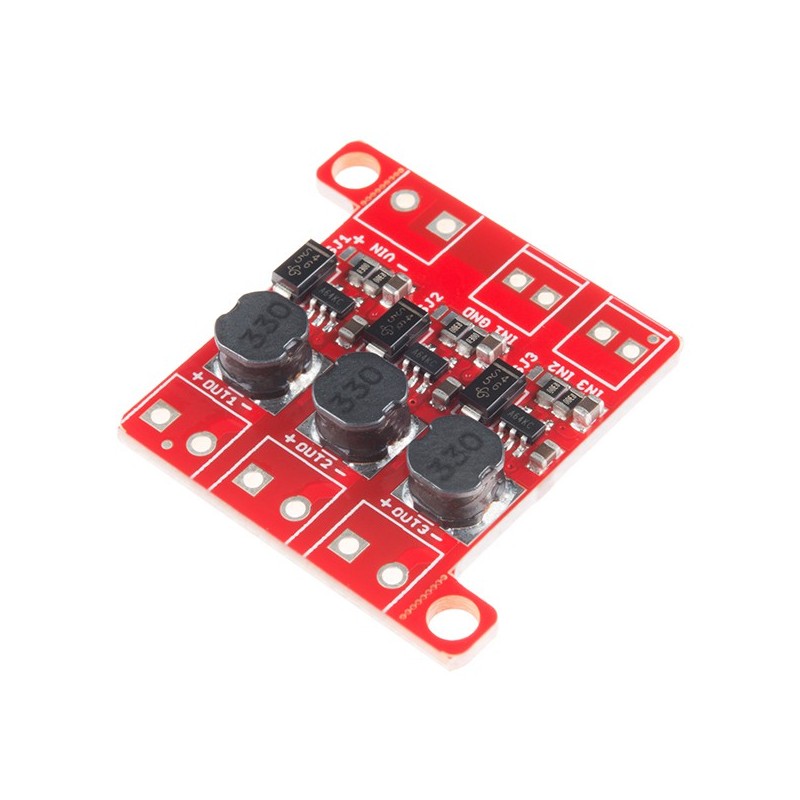






zł74.98 tax excl.
The PicoBuck LED Driver is an economical and easy to use driver that will allow you to control and blend three different LEDs on three different channels. By default, each channel is driven at 330mA; that current can be reduced by either presenting an analog voltage or a PWM signal to the board. COM-13705
The PicoBuck LED Driver is an economical and easy to use driver that will allow you to control and blend three different LEDs on three different channels. By default, each channel is driven at 330mA; that current can be reduced by either presenting an analog voltage or a PWM signal to the board. Version 12 of the board adds a solderable jumper that can be closed to increase the maximum current to 660mA. The new voltage regulator also increased the voltage rating on the various components on the board, allowing it to be used up to the full 36V rating of the AL8805 part.
Three signal inputs are provided for dimming control. You can use the PWM signal from an Arduino or your favorite microcontroller to dim each channel individually, or you can tie them all to the same PWM for simultaneous dimming. Dimming can be done by an analog voltage (20%-100% of max current by varying voltage from .5V-2.5V) or by PWM (so long as PWM minimum voltage is less than .4V and maximum voltage is more than 2.4V) for a full 0-100% range. A small jumper is provided for each channel to allow you to increase the drive strength from 330mA to 660mA. Two mounting holes for 4-40 or M3 screws are provided on either side of the board. They are perforated so they can be easily snapped off with a pair of pliers, if a smaller footprint is desired.
Manufacturer BTC Korporacja sp. z o. o. Lwowska 5 05-120 Legionowo Poland sprzedaz@kamami.pl 22 767 36 20
Responsible person BTC Korporacja sp. z o. o. Lwowska 5 05-120 Legionowo Poland sprzedaz@kamami.pl 22 767 36 20
The PicoBuck LED Driver is an economical and easy to use driver that will allow you to control and blend three different LEDs on three different channels. By default, each channel is driven at 330mA; that current can be reduced by either presenting an analog voltage or a PWM signal to the board. COM-13705
No product available!
This tiny microcontroller card connector plugs into your computer\'s USB port, allowing you to power and control your NeoPixel (SK6812, WS2812) or DotStar (AP102) LEDs without soldering or complicated wiring.
No product available!
A compact converter designed to drive LEDs in series and parallel circuits. The device generates voltages up to 40V and currents up to 400mA from a 3-5V supply, with the output current adjustable via mini DIP switches. The board features a built-in 1.2A switch, overvoltage protection, and PWM LED dimming. Adafruit 6354
Controller with 5 m RGB LED strip (10 LEDs per meter). The LEDs are mounted on a flexible white PCB. Communication is via the Grove interface. Seeed Studio 104020005
RGB LED strip controller with WiFi communication. It enables remote control of multi-colored strips with diodes powered with voltage from 5V to 28V using a mobile application. SL-LC01
RGB LED driver module equipped with ATtiny1616 microcontroller and STEMMA QT connector. It uses a 3.3V/5V voltage level converter and allows you to control the popular Neopixel LEDs. Adafruit 5766
A set of elements that allows you to build an economical lamp powered from a mains socket using a standard micro USB charger. In this version, a dedicated board is used, which makes the set more aesthetic and easier to assemble. Kitronik 2161
Module with RGB LED, adapted to operate with a voltage of 5 V. Ideal for applications such as decorative lighting, visual effects or microcontroller projects
No product available!
The PT4110E89E is an advanced step-up LED driver designed to power white LEDs in applications requiring stable current and high energy efficiency. It provides an output current of up to 1.5A at a supply voltage of up to 5.5V, making it an ideal solution for low input voltage LED lighting
Module with RGB diode and P9813 controller. It is powered with the voltage of 5 V and controlled by the I2C interface (Grove). Seeed Studio 104030006
LED and audio controller designed for lighting effects in LEGO® compatible models, dioramas and decorations. It offers six mono channels, one RGB channel, audio amplifier, sensor inputs and a Qw/ST connector – all without the need for soldering. It enables the creation of advanced animations, lighting effects and synchronized audio in a compact form factor. Pimoroni PIM719
The Pico-DALI2 module enables the implementation of DALI2 communication in projects based on ESP32-C6-Pico and ESP32-S3-Pico boards. Thanks to its compatibility with the Pico interface, DALI screw terminals, and ready-to-use programming examples, it is well-suited for smart lighting and building automation applications.
WiFi controller dedicated to LED strips based on addressed diodes, including the popular WS2812, WS2813 and WS2815. SP108E
LED driver with built-in RM2 module, offering Wi-Fi, Bluetooth and power supply up to 3A via USB-C. Supports remote lighting control, integration with automation systems and extensions via Qw/ST connector. Ready to use out of the box, ideal for decoration, light installations and artistic projects. Pimoroni PIM729
No product available!
RGB LED driver module designed for QT Py and Xiao boards. It uses a 3.3V/5V voltage level converter and allows to control 30 Neopixel LEDs. Adafruit 5645

The PicoBuck LED Driver is an economical and easy to use driver that will allow you to control and blend three different LEDs on three different channels. By default, each channel is driven at 330mA; that current can be reduced by either presenting an analog voltage or a PWM signal to the board. COM-13705
